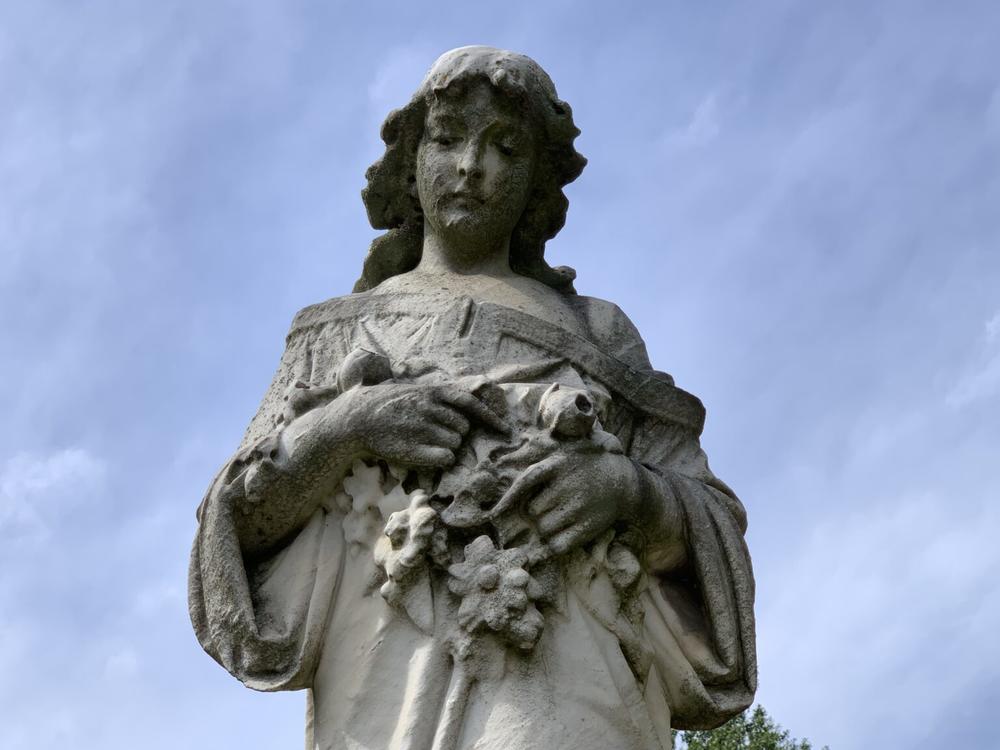
Caption
As the story goes, Ida Bennett Bass may be one of Oakland Cemetery’s more restless residents. Pictured is the statue at Bass’ gravesite.
Credit: Jill Nolin/Georgia Recorder

As the story goes, Ida Bennett Bass may be one of Oakland Cemetery’s more restless residents. Pictured is the statue at Bass’ gravesite.
Plastic skeletons and blanket ghosts are festooned over yards across the state, ready to welcome trick or treaters on Halloween.
But in communities all over Georgia, storytellers and historians whisper dark tales of the past that are more hair-raising than any inflatable lawn ghoul, and some say remnants of that past linger today in old or forgotten places.
Some are firm in their belief in the supernatural; others say these ghost stories are nothing more than a fun way to learn a little bit about life in the old days.
But wherever you fall on that spectrum, there’s no denying Georgia is home to some truly macabre history. Here are some favorite Georgia ghost stories from tour guides and historians from across the state.
In 1915, there was nothing better than a circus coming to town, and on one particular November afternoon, a train full of performers from Con T. Kennedy’s traveling circus was en route to Alabama to put on their next show.
“He was probably just as popular as P.T. Barnum, but in the South,” said Victor Feliciano, owner-operator of Vicinity Tours in Columbus. “He wasn’t like nationwide like P.T. Barnum was, but they had their own trains. P.T. Barnum hit the bigger cities, and it appears that Con T. Kennedy would go to the smaller towns.”
The train’s wooden cars were full of colorful performers — Siamese twins, acrobats, a brass band, jugglers and clowns — as well as performing animals and equipment like a Ferris wheel and big tents slicked with oil to keep out the rain.
But none of them knew they had already performed their final acts.
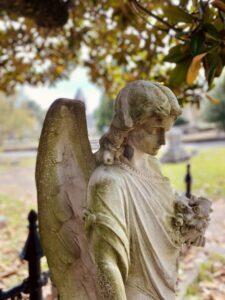
The Recorder’s Ross Williams caught up with tour guides, historians and yarn-spinners across the state to resurrect some of Georgia history’s more hair-raising tales.
Meanwhile, the conductor of a steel passenger train bound from Columbus to Macon was stopped at Muscogee junction, where the conductor received a message.
“Apparently, the conductor didn’t hear the message, or if he did, he didn’t pay heed to it, or it could have been he didn’t care,” Feliciano said. “The train must go on. But it rolled out on schedule at 1:30. The thing is that the message was to wait for about 10 minutes so that the circus train can pass through and then they can go ahead.”
The trains collided into a cacophony of explosions, shattering wood and buckling metal. Only a few injuries were reported on the passenger train, but the performers were not as lucky.
“Unfortunately, the circus train was made of wood except for the engine and the caboose, and the caboose actually made its way into the engine compartment, basically smashing animals and people that were from the circus train,” Feliciano said.
Rescue efforts were hindered by the oiled tents, which fed the flames, and the fact that nobody knew how many people were supposed to be on the train.
“Back then, the circus people would hop on and hop off, so no two shows were exactly alike because it all depended on how many people were at the tent at the top of the show,” Feliciano said.
It is believed that 24 people died that day, but some in Columbus remember the story more for one miraculous survivor.
Knowing they had no chance to escape the twisted wreckage, the mother of young Hazel Kempf managed to pass her through a small window as the flames grew around them.
“She knew the inevitable was about to happen, and unfortunately, the windows of the circus train weren’t big enough for the adults to climb through,” Feliciano said. “And so what she did was she grabbed her daughter and put her out the window.”
Little Hazel escaped with minor injuries. She became the darling of Columbus, and she would go on to live a happy and successful life, passing away in 1999 at the age of 84.
Kennedy, the circus owner, built a monument carved to look like a circus tent in Riverdale Cemetery as a tribute to those who died in the wreck.
Feliciano said his Wicked River Cities Tour is about teaching history rather than the paranormal.
“Personally, I don’t really deal with the paranormal, I don’t really want to play with it,” he said.
“I have a, I won’t say a fear, but I have a strong respect for the spiritual realm, and I’ve got enough demons in my life, I don’t need to invite any more,” he added with a laugh.
Still, he says people on his tours have sent him photographs that they say contain ghostly orbs, and generations of Columbus schoolchildren have whispered about hearing carnival music and seeing oddly-dressed people near the cemetery late at night.
At five stories, the Landmark Building is the tallest building in downtown Dalton and also one of the city’s most historic structures. The original 1890 building, then called Hotel Dalton, was destroyed by a 1911 fire that devastated the downtown, and it was restored in 1923. It now serves as office space.
When local historian Connie Hall-Scott began leading haunted ghost tours around the city, she at first did not include the old building in her stops, despite employees there reporting strange occurances.
“Everyone who worked there believed it was haunted because of a heavy feeling, like someone or something is there that isn’t, that sort of thing, and also a disembodied cry, like a woman crying when there actually wasn’t a woman crying there,” she said.
Hall-Scott dug into the building’s history, but didn’t find anything that could indicate it had been haunted, and calls to the owners also yielded no leads.
She put the tales of the weeping woman aside, until a chance conversation with her father, a former police officer, helped her put the pieces together.
Hall-Scott and her parents were passing the Landmark after she had taken them on a tour one night.
“After the tour, my dad said, ‘Hey, did I ever tell you about when I was a Dalton police officer and the suicide case I worked at Hotel Dalton?’ And of course he had not,” she said.
In the late 1960s, a woman checked into Hotel Dalton. People remembered her as a pretty young lady, about 17 or 18, who had taken a job as a carhop at the Cherokee Drive-in movie theater.
What they didn’t know was that she had been involved in a relationship with an older man, who apparently had cut things off, leaving her distraught. Some versions of the story say she had become pregnant.
Broken-hearted, she brought a pistol up to her third-floor room and ended her short life.
When she did not leave her room, the hotel staff sent a bellhop to check on her. He discovered the grisly scene and called the police, and Hall-Scott’s father, who was still relatively new on the force, was sent to investigate.
Hall-Scott said she confirmed the story with her father’s former partner, the coroner at the time, and even the bellhop who discovered her.
That’s when she started to believe the weeping sounds employees reported came from the spirit of that unfortunate woman, and she says a visit from an Atlanta psychic in 2011 confirmed it for her.
Hall-Scott said the psychic honed in on the Landmark Building without prompting during one of her downtown tours, and she knew details of what happened that she had never published or shared with anyone.
“She’d never been to Dalton before,” Hall-Scott said. “She turned around, and she was like, ‘Wait, what is that building? Don’t tell me. Let me tell you.’ And she went through this whole process of there’s a young lady, she’s on the third floor, she doesn’t want to move on because she’s afraid that she might go to ‘the bad place,’ which is the way she said it. It was over a man and she shot herself. And she was very dramatic, she talked about how, as the young lady had started pulling the trigger, time kind of elongated, stood still. And she didn’t want to do it anymore, but it was already happening, and she’s there, and she’s very, very sad.”
Originally built in 1850 and filled with beautiful gardens and elaborate stonework, Atlanta’s Oakland Cemetery draws more than 100,000 visitors each year.
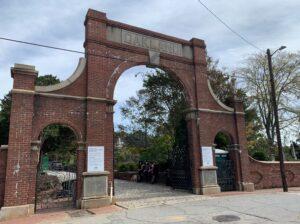
Atlanta’s historic Oakland Cemetery is the burial location of a Rome woman. But some say her spirit does not stay there.
Its permanent residents include former mayors like Ivan Allen Jr. and Maynard Jackson, Gone with the Wind author Margaret Mitchell and country music legend Kenny Rogers, as well as less savory characters.
“Oh, man, you know, with 70,000 people, we’ve got people who are victims of crimes, we have people who are perpetrators of crimes, quite a lot of folks, murdered people, people who died in very violent ways,” said Marcy Breffle, education manager for the Historic Oakland Foundation.
The site regularly tops lists of Georgia’s most haunted places, with visitors reporting apparitions dressed in Civil War garb roaming the grounds.
Breffle remains skeptical.
“When people usually ask if Oakland is haunted, we say no, because if you think about it, if you believe in spirits, they would usually haunt the places that they lived in,” she said. “By the time they get to Oakland, you know, they’re already dead.”
But everyone loves a good ghost story, and one of Breffle’s favorites is about a woman named Ida Bennett Bass, who lived in Rome, Georgia.
Ida was pregnant with twins, but her husband had to leave town for business, so Ida’s mother came to visit to take care of Ida as her due date approached. But the delivery did not go well.
The first child, a girl, was healthy, but the second, a boy, was stillborn, and Ida herself died shortly after giving birth.
Her mother was devastated, and she blamed her son-in-law for abandoning his wife and children when they needed him. She was so upset that she refused to allow Ida to be buried in the Myrtle Hill Cemetery in Rome and brought her down to Oakland. But some say her spirit does not stay there.
“The story goes that Ida’s ghost, every October, will leave Oakland and will go up to Myrtle Hill Cemetery in Rome, Georgia to visit her husband and her children,” Breffle said.
Breffle’s favorite stories are more grounded, including an unexpectedly uplifting one she likes to tell couples.
It’s about a man named Marion Kiser, whose two wives had died and were buried in Oakland. One day, he was in the cemetery to pay his respects at their graves in his family plot.
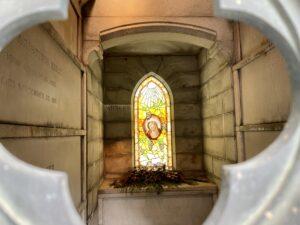
Inside the Kiser mausoleum at Oakland Cemetery.
“A little bit across the cemetery, this woman is doing the same thing, she was there to visit the grave of her late husband, and her name was Sarah Ivey and her husband’s name was Michael. I don’t know if they just locked eyes over the cemetery or what happened, but they ended up meeting and talking and courting one another.”
Love bloomed in the graveyard that day. The two fell in love, and eventually, Kiser proposed.
Ivey was happy to accept, but she had one hitch.
“Sarah said 'I can marry you, but on one condition: Michael needs to move into the Kiser plot,'” Breffle said. “'I told him that we would be together forever, and that means that I would be by his side into the afterlife.'”
Kiser agreed and the two were wed, and to this day, the Kiser mausoleum is the only one in the cemetery that contains two husbands and three wives.
The University of Georgia’s famous cast iron arch marks the gateway between the campus and the city of Athens. Every day, countless students walk between its three pillars, which represent components of the state of Georgia’s motto: wisdom, justice and moderation.
Few, however, know the story of its creation and its links to the dark side of Georgia history.
The arch was made by ironworkers at the Athens Foundry in 1857 as part of what was then a fence around the campus.
The foundry, established in 1850, used a mix of slave and free labor at the time of the arch’s construction, said historian Jeff Clarke, so it’s likely that slaves were involved in its creation.
Even for free men, it was grueling, sometimes dangerous work. Debilitating and fatal injuries were common in iron foundries at the time.
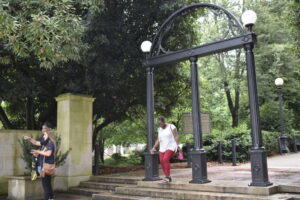
UGA Arch
When he takes tour groups to the old foundry site, Clarke points out the bricks that make up the building, bricks he says still bear their fingerprints.
“We want to tell their story, we want to highlight the work that they did,” Clarke said. “And then we go on to talk about the fact that there seems to be missing pieces to the history of the building with regard to the fatality rate. Foundries were very dangerous, very nasty work. There was a relatively high mortality rate in these things. This was making iron under really primitive conditions, and there were accidents. But this particular place has no real mention of those, whereas other other facilities do document that. So, we have a beginning for this particular building that is rather ominous.”
Athens and the University of Georgia have old connections with slavery that some in current leadership would rather not remember.
While the university itself did not own slaves, it did rent their labor, and enslaved people performed tasks on campus ranging from carrying water and gardening to cleaning rooms and carpentry, according to the university. Some faculty did own personal slaves, and others contributed to intellectual arguments supporting the practice.
The university came under the spotlight in 2015 when workers uncovered numerous graves that DNA tests determined contained the bodies of African Americans. It is believed the site was a burial ground for slaves.
The former foundry has been converted into an upscale hotel, but guests report some otherworldly happenings that they cannot rationally explain.
“There are reports of people seeing shadow people, in other words, people out of the corner of their eye, even though they’re the only ones in the room,” Clarke said. “Employees there have reported late at night, after all the guests are gone from the bar area, the sound of whispering or talking or something like that. Also, one of the rooms seems to have a telephone that will ring to the lobby, even though no one is occupying that room.”
In 1971, Randall Widner had the job of his dreams as executive director of Macon’s Grand Opera House, which has been entertaining crowds since 1884.
By all accounts, Widener loved his job and loved the opera house, overseeing a major restoration of the premises.
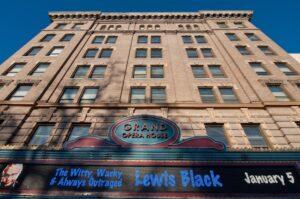
By all accounts Macon's Grand Opera House has at least two spectral residents.
But all was not well in his life, and on one fateful night, he climbed high above the stage to an area called the thunder room, which held big metal plates used to make thunder sound effects in old plays.
“He had crawled up there with sleeping pills, whiskey, and a pistol,” said Katie Roberts, tour guide with Rock Candy Tours in Macon. “And he didn’t have to use the pistol because he chased the pills with the whiskey, and he took his life in the theater that he loved so dearly.”
Ever since then, guests and workers have said they have felt, seen and heard strange things. Workers closing for the night will find the lights on after they turned them off and left the room. Maintenance workers say they’ve climbed to the top of the house to change a lightbulb, only to discover it wasn’t dead, it had merely been unscrewed.
“There have been a lot of incidents, guests and staff reporting seats flipping, music playing with no source that can be traced,” Roberts said. "People who are working the spotlight, so they’re in the balcony area, reporting breezes going by them or feeling like someone’s blowing on their neck and then turning around and nothing’s there."
Some of the people at the theater say they see Randall as a harmless spirit keeping an eye on the stage he loved so much in life, and maybe pulling a few playful pranks every now and then. But by at least one account, the theater has another spectral resident, the lady in white.
Her appearance predated Widner’s death, when a fire marshall on an inspection heard a woman’s voice singing opera. When he went to the stage to find the singer, he saw a woman there he would never forget.
“He said that it was a ghost of a woman in a glittering gown, and he describes the ghost going across the stage and then through the theater aisle towards them before it just vanishes,” Roberts said.
Savannah is known for its charming buildings and fascinating history, but beneath the surface is a ghostly secret, says Dan Riedel, co-owner of Savannah History and Haunts.
“The city is built on top of the dead,” Riedel said. “The majority of the downtown Savannah historic district has these burial plots where they built these houses over, they built squares over. Half the town is the Revolutionary War battlefield where the dead were buried beneath in trenches, and there’s houses above it, there are yellow fever pits, like in Calhoun Square and Whitfield Square, and all these peoples’ houses are built above them.”
While it is a major tourist draw now, Savannah has been home to more than its share of death and misery.
Gen. William Tecumseh Sherman famously spared Savannah from his army’s torches at the end of his march to the sea, but Savannah did not escape the Civil War unscathed. It was a major hub for refugees and wounded troops alike.
“As Sherman’s marching to the sea, he’s burning down every town in his path, but everyone in those towns is trying to get in front of the army and get away from him before he gets there, and they’re all being funneled into one area — and that’s Savannah,” Riedel said. “So that was hospitals, prisons, injured, dying soldiers from nearby battlefields, families that are homeless because their house burned down, their slaves, all of that was pushed into a town that was already being cut off because Fort Pulaski was blown up. They already had been cut off, no supplies coming in, and the town was overwhelmed.”
As if a Civil War were not bad enough, Savannah also faced three major yellow fever epidemics during the 19th century. Today, the disease is preventable and rarely kills in the U.S., but back then, it was a new and terrifying thing.
Sufferers usually develop fever, muscle pain and vomiting, and in severe cases, the virus attacks the liver and kidneys, causing the skin and eyes to turn yellow and giving the disease its name.
Patients who enter the toxic phase can experience severe pain and bleeding from the mouth, nose and eyes.
Many of those with the means to flee town did so, but most had no choice but to stay.
“Between the wars and disease, I would say the number one thing that hurts Savannah was the yellow fever,” Riedel said. “The one that hit in 1820 was one of the worst that could have hit the town because Jan. 11 of 1820 is when the great Savannah fire broke out, and it burned down over 500 buildings, and after that fire is when the yellow fever hit. And that’s the worst time it could have hit because half these people are living in tents in squares. There’s roughly 700 people alone buried in Colonial Park Cemetery from the yellow fever of 1820.”
At the end of the century, in 1898, a devastating hurricane with the same force as Hurricane Katrina struck the city, instantly killing about 2,000 people and making refugees out of another 30,000.
With such a dark history, it’s little wonder so many residents report seeing spirits, hearing unexplainable sounds and feeling a sudden rush of dread in the late hours.
“It is just one of those things where so many people have had their experiences, and then you read about and it matches so many other people’s experiences over the years, and that’s what I find fascinating because you could take generations of people that never knew each other, but they’ve all had a similar experience in the same location,” Riedel said.
Not only are ghosts part of the neighborhood, they’re also part of the local economy.
“If you look at this area, you are going to see there are so many ghost tours operating in town, but it’s an attraction. It’s almost a selling point in some of these places,” he said. “Airbnbs and bed and breakfasts advertise their places are haunted. Some of them leave pamphlets on your pillow telling you about the ghosts that are inside. As a matter of fact, a house that was for sale a couple years ago had ‘resident ghost’ in the listing. It’s a selling point in this town.”
This story comes to GPB through a reporting partnership with Georgia Recorder.